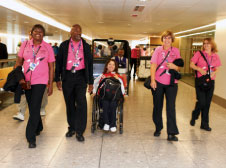
1,000 volunteers were recruited from local communities to assist travellers at London-Heathrow. The airport hopes this success will be continued. “We would like to have permanent volunteers, local people, working with us to welcome passengers to London and provide the best possible passenger experience,” commented Cole.
The eyes of the world were on London this summer and London-Heathrow, as official ‘Host Airport’ of the Olympic and Paralympic Games, was firmly in the international spotlight. The phenomenal efforts of ‘Team GB’ were matched by the airport’s own Olympian achievements in successfully welcoming 80% of all Games-related traffic, including several hundred thousand spectators and more than 10,000 athletes.
During the Olympics and Paralympics, more than 75,000 journeys were made by Paralympians, Olympians and team officials, and over 2,800 wheelchairs were processed. The airport also handled 5,000 oversized bags including canoes, javelins, bikes and pole vault poles; 1,300 firearms plus ammunition; and 20,000 members of the media. The peak arrivals day for the Paralympic Games was 22 August, when London-Heathrow welcomed 2,100 Paralympic athletes and officials.
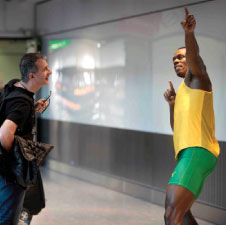
A Usain Bolt wax figure was unveiled in London-Heathrow’s Terminal 5, courtesy of Madame Tussauds.
The challenge during the Paralympics was the complexity of passengers’ needs rather than the volume of passengers and bags, meaning it wasn’t necessary to use the temporary Games Terminal for departing Paralympians. However, 300 volunteers waved off each Paralympian with a Guard of Honour bidding them farewell.
Improving accessibility
The Paralympic Games naturally presented a different and greater operational challenge than the Olympic Games, given the complexity of handling increased numbers of Passengers with Reduced Mobility (PRMs). “The Heathrow team has spent the last seven years preparing for this challenge,” explained Cole. “We conducted rehearsals to test our processes and procedures, and have spent more than £20 million (€25m) in preparing for the Games. This includes installing new ramps and lifts to manage the number of passengers with reduced mobility using Heathrow, and we have given extra training for our staff and volunteers on the safe way to handle specialist wheelchairs.”
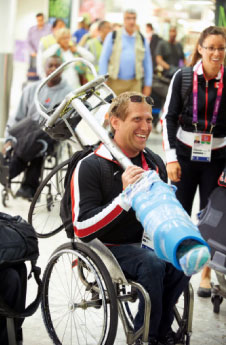
London-Heathrow handled 5,000 oversized bags during the Games period, including canoes, javelins, bikes and pole vault poles; 1,300 firearms plus ammunition; and 20,000 members of the media.
In order to meet the challenge posed by the Paralympic Games, London-Heathrow partnered with mobility charity Whizz-Kidz. The charity offered first-hand, expert guidance on how to further improve the airport’s accessibility. It audited London-Heathrow’s terminal facilities and suggested a number of improvements, including increasing the number of specialist lifts, known as ambilifts, which are used to help PRMs embark and disembark aircraft. Heathrow now has 12 ambilifts – more than any other airport in Europe. The charity also recommended obtaining 13 scissor lifts and installing 100 new ramps to help load and unload wheelchairs; upgrading and increasing its fleet of buggies for transporting PRMs through the airport to a total of 60 vehicles; installing four new lifts to help return wheelchairs to the aircraft door; increasing the number of lightweight aisle chairs and self-propelled wheelchairs to 38 and 20 respectively; an onsite wheelchair repair service; and installing new accessible toilets. These improvements provide a positive lasting legacy, and Cole explained that this enhanced level of accessibility for PRMs was a key aim. “We are very passionate about this and this dedication is becoming infectious across the airport,” he commented.
Omniserv at London-Heathrow
Since Omniserv took over the PRM contract at Heathrow volumes of PRM passengers have risen month on month, year on year. In 2010 the volume was 778,429, in 2012 it will probably be a little over 900,000. Omniserv saw its busiest month ever – May this year, with almost 90,000 PRMs and its busiest day ever with over 3,400 PRMs. Volumes are being driven from various points. Passengers are becoming more aware of the services available to them and more knowledgeable about the legislation. The ageing population means more people want to travel.
To manage these volumes and provide services at a price that airports and airlines are willing to pay, Omniserv has had to find ways to be more productive and strategic in the way it handles PRMs and, of course, it has deployed more staff. It has increased buggy numbers and capacity, updated IT hardware and worked closely with BAA to find ways to move transfer passengers around the airport quicker and more easily.
What all PRM providers know is that pre-notification is vital information to be able to provide an effective and quality service. Omniserv has worked closely with many airlines on an individual basis that has seen pre-notification increase in the last 2 years. This was especially important for the handling of the Paralympic athletes. While Omniserv was aware of total volumes many months in advance, the finer details only became available in the 2 weeks before the event but meant that all the athletes received a prompt and warm welcome at Heathrow.
Omniserv worked closely with the IPC, LOCOG and BAA throughout its planning for the Paralympics. It attended the Para-PanAmerican Games in Mexico and also spent time with GB athletes. It learnt a lot about the needs of the athletes, how the teams work together and assist each other when travelling and just what they wanted from Omniserv. After developing processes on paper, they were tested with staff on empty aircraft and then refined when handling athletes for the many test events. Omniserv handled over 1,700 wheelchair athletes in and out of Heathrow, with over 1,000 leaving on one day on 10 September.
‘Best possible passenger experience’
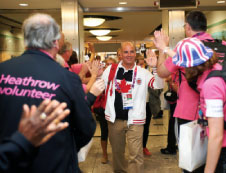
On 10 September, London-Heathrow waved goodbye to 5,000 departing Paralympic athletes and officials.
While diligent preparations were made to ensure the smooth handling of additional Games traffic, it was business as usual for the 19 million other passengers using the airport during the same period. A real sense of theatre was created to enhance the experience of all passengers travelling through London-Heathrow. There were appearances by the iconic Beefeaters, London 2012 mascots and Queen’s Guards in each terminal; performances by the London Philharmonic Orchestra and Salvation Army Brass Band; the unveiling of a Usain Bolt wax figure in Terminal 5, courtesy of Madame Tussauds; and table tennis tables for passengers to try out the Olympic sport.
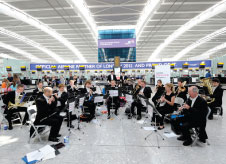
A real sense of theatre was created to enhance the experience of all passengers travelling through London-Heathrow, including a performance by the London Philharmonic Orchestra.
1,000 volunteers were recruited from local communities to assist travellers and Cole added that they had a hugely positive impact, which he hopes will be continued after the Games. “We would like to have permanent volunteers, local people, working with us to welcome passengers to London and provide the best possible passenger experience.”
The focus now is on the London 2012 legacy and many of the improvements at London-Heathrow will continue to benefit passengers for years to come. “Heathrow is proud to have been the ‘Host Airport’ and of the part we have played in delivering a successful Olympic and Paralympic Games. We want to capture the benefits brought by the Paralympic Games into our regular business as usual process to continue to make every journey better for all our passengers,” concluded Cole.







